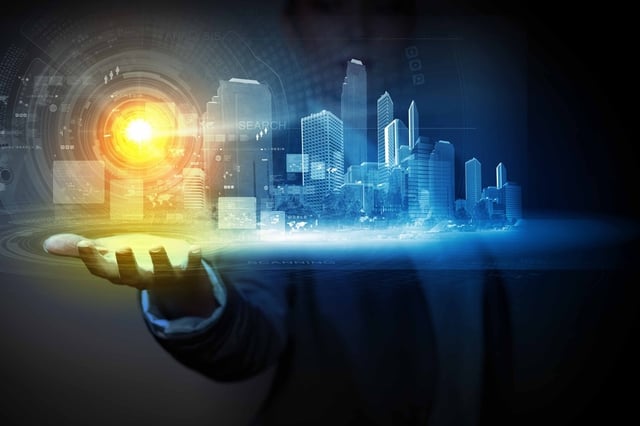More data than ever before is being collected by thousands and thousands of sources in a city, from road sensors to traffic cameras to boarding pass check-ins. This is far more data than any person or team of people could process, especially when you consider that by 2030, at least one in three people will live in a city that has at least 500,000 people.[1]

Why Artificial Intelligence for City Development?
With so many people to protect and serve, machines are required to automate processes and generate ideas. Artificial intelligence (AI) is a concept and developmental process that we use to generate computer algorithms that look for patterns and connections in data, learn from that data, and provide useful or valuable information that we humans can use to improve lives.
What kind of information? Face recognition, music, TV, and shopping recommendations based on usage and buying patterns, and optimal traffic routes are easy examples. Others include financial sector predictions, environmental and industrial planning, product design, public safety improvements, and global and local connectivity, even with language barriers.
The Challenges of AI in the City
With information gathering, storing and delivering comes a few tactical challenges:
Continuous, Reliable Power: How will these machines receive the power they need on the move, over time, and in crowded, complex spaces?
Simple Maintenance: Who will manage the delivery and maintenance of this energy delivery?
Built-in Security: How will our cities’ communal data remain secure in a world where global cyberattacks are becoming common?

Wireless Power Provides Reliable Energy to Cities’ Ongoing AI Needs
Real wireless power is destined to be an integral part of AI growth. Real wireless power like Ossia’s CotaⓇ technology is delivered without the limitations of wires, laying building cables, and leaving a device on a charging mat.
Cota is delivered automatically to only those devices that need it and have permission to receive it, according to a cloud-based management platform, even if those devices are not in sight of the transmitter and are moving.
And with no user intervention required to keep power flowing, wireless power like Cota is virtually maintenance free.
Wireless Power Should Not Rely on End-User Intervention
Artificial intelligence is not bound by visual data, it can also be related to temperature, pressure, depth, sound, moisture, speed, and even health vitals. This amount of data requires always-on devices that have a reliable source of power that does not cause the waste of batteries or the dependence on plugging in. In other words, we should not rely on the end user to ensure that devices are receiving power.
What’s more, many devices need a receiver that is tiny enough to fit, for example, into an environmental sensor or implantable medical device, and able to send the data that the user needs to stay safe and informed. End users simply cannot reach such small, inaccessible spaces.
Wireless Power Enables Two-Way Communication for Community Safety
With AI fueled by wireless power, cities are able to continuously gather and process data from road sensors, weather stations, traffic cameras, and law enforcement devices and spot things like traffic patterns, community planning needs, and ideas to keep citizens safe, in real time. This information can then be provided back to the user, in aggregate or at an individual level, to alert them about such things as a potential community safety issue or even a low pressure tire on a bus.
How Cota Real Wireless Power Works
Ossia’s Real Wireless Power technology is licensed to manufacturers and service providers around the world. It works on a safe-for-humans 2.4 GHz radio frequency, just like WiFi and Bluetooth, and can deliver power up to 30 feet in circumference with just one transmitter to dozens of devices. Linking transmitters extends the power or distance, whatever is required of the devices at the time.
The devices themselves — from automotive sensors and electronic shelf tags to medical devices and smartphones — have a tiny microchip-sized receiver built right in by the manufacturer. The receiver sends out a beacon, which bounces off of walls and things, but not people, to find the transmitter. The transmitter then sends power along these same exact paths, again avoiding people and pets, to power the device.
Cota works without charging pads, plugging in, or line of sight. It’s the wireless power that will enable smarter, safer, more connected cities for all of us.
[1]http://www.un.org/en/development/desa/population/publications/pdf/urbanization/the_worlds_cities_in_2016_data_booklet.pdf






